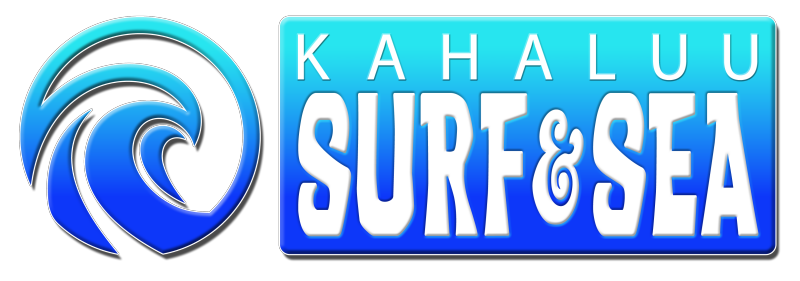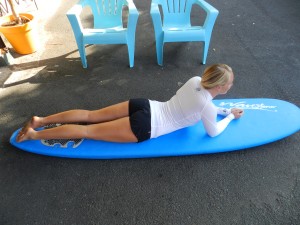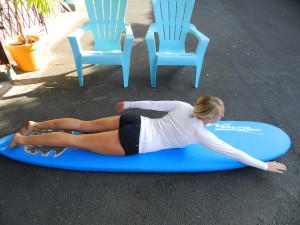How to Correctly Paddle on a Surfboard
When learning how to surf in Kona, Hawaii, knowing how to correctly paddle on a surfboard is essential to catching lots of waves.
The faster and more efficient of a paddler you are, the more likely you are to catch a few waves. Here are some basic tips that will help you correctly paddle on a surfboard and minimize the amount of effort needed to do so.
Finding the Sweet Spot
Before beginning to paddle for a wave, you want to find the sweet spot on your surfboard. This is the area were you will have the most balance and easiest time paddling for waves. When you lay down on your surfboard, your body from head to toe should lay down the center of the surfboard; kind of like laying on a very wide balance beam. This will make the surfboard lay flat on the water and not tip to the left or right.
When you paddle on a surfboard you want to make sure you are not laying too far forward. Having to much weight at the front or nose of the surfboard will cause you to pearl or nosedive when you try and catch a wave. This is not a fun way to wipe out since most nosedives usually send water straight up your nose. To prevent the surfboard from pearling, make sure that your are back toward the tail end of the surfboard. Be careful, having to much weight on the back or tail of the surfboard will cause the board to drag through the water and slow you down. Ideally, you want your torso to lay at the center of the surfboard for the best balance. You may have to adjust your position on the surfboard a few times until you get it right.
Positioning for the Wave
Once you have found the sweet spot on the surfboard, you can try and catch a few waves. We recommend positioning yourself to catch waves that have already crashed further out and have a rolling whitewash. These are the easiest and safest waves to catch when you are a beginner.
Make sure your surfboard is pointing directly to the shore when you begin to paddle for a wave. If your surfboard is angled even by a small amount to the left or right, the wave will push the surfboard sideways and roll you off the board. This is one of the biggest mistakes that surfers make when learning to paddle on a surfboard correctly.
Give yourself enough time to get some momentum by starting to paddle before the wave gets to you. The more speed you get, the better chance you will have at catching the wave.

When the wave picks up the tail of the surfboard, paddle extra hard to make sure you catch the wave.
Correct Paddle Techniques
To paddle, cup your hands to do long free style swim strokes bringing as much water as the can from the font of the surfboard to the back. You don’t have to paddle super fast just make sure that each paddle stroke is completed smoothly. As you paddle toward the shore, the wave will pick the tail of your surfboard up. Most people make the mistake of standing up when they feel this happen and the waves rolls under them. When the wave lifts up the tail of the surfboard, paddle twice as hard as you were before. These are called burst paddles. After a few burst paddles, the surfboard will start to slide down the wave on its own. Congratulations, you have caught the wave. Now its time to pop up to your feet and surf as long as you can.
If you have a secret paddling technique that helps you catch waves easier, feel free to share it with us.
Want to improve your paddling techniques and catch more waves, get surf lessons with us in beautiful Kona, Hawaii.








Hi, Nice post and Thank you for tips.
[…] you decrease your board’s thickness, length, and width, paddling will become a lot more difficult. Longboards are easier to paddle because the thickness helps to […]
Hi – thanks for the article. I’m moving from a mini-mal to a 9’2″ longboard and am confused about where to lie when taking off. With the mini-mal its pretty straightforward – just have a bit of nose out of the water. However on the long-board I don’t know whether I should have my feet/toes at the back (as I’ve seen in other photos) or whether I should be well forward. It just seems that if I’m lying in the middle of the board there seems to be a helluva’ lot of board in front of me. And its not as easy to catch waves as I thought it should be which tells me I’m not in the right spot. But whenever I move forward I seem to pearl. I’ve googled heaps of articles on where to lie for the take-off but they all seem to be short-board focussed. Any help/advice would be appreciated! Thanks (from N.Z.)
[…] or right when they see a big one coming. This usually ends in them getting sloshed back to shore. Don’t let this be you. You pretty much have two options when paddling out into waves: Either duck dive under it or paddle […]